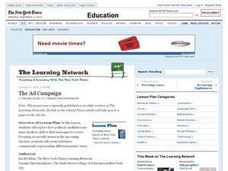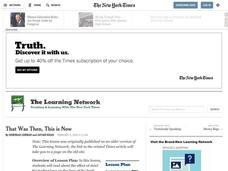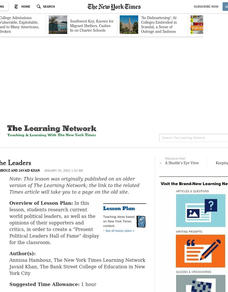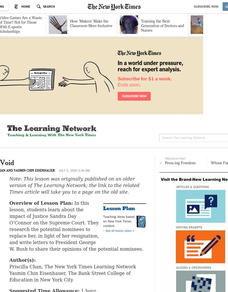Curated OER
Lesson 11: Printed Materials (Ads and Broadsides) 1780-1820
Students use primary resources (gazettes, broadsides, advertisements) to consider life at the turn of the 18th century in Deerfield, Massachusetts. They infer observations about life in the nascent United States.
Curated OER
Ancient History Cyber-Journalists
Students explore the ancient past. In this ancient civilizations lesson, students research ancient events and write newspaper articles about the events. Students work in teams of 4 to produce group newspapers that feature their findings....
Curated OER
Commemoration of the Gettysburg Battlefield
Students use a multimedia project, The Valley of the Shadow: Two American Communities in the Civil War, to create a presentation about the significance of the Gettysburg Address. They work on expert teams to explore the interactive...
Curated OER
The Ad Campaign
Young scholars explore how political candidates use mass media to deliver their messages to voters. Focusing on specific issues in the upcoming election, students create television commercials representing different parties' views.
Curated OER
Social Studies: Public Service to a Better Image
Students, in a program entitled "Strategies for Success," examine ways to change public perception of their school. In this project-based lesson plan, they explore local social and environmental issues, develop a conflict resolution...
Curated OER
Commas
Fifth graders discuss when a comma is necessary in a sentence. In this language arts lesson, 5th graders understand that commas are used as a pause and help the reader understand ideas better. Students find an example of each example...
Curated OER
Adjectives
In this adjectives practice worksheet, learners choose describing words with opposite meanings. Students complete twelve sentences.
Curated OER
Brick Memorial Flyer
Students conduct research using the internet, school server and newspapers on the history of the brick memorial for veterans and its developmental process. They create and design a three column page layout for a brochure using Microsoft...
Curated OER
That Was Then, This is Now
Learners read about the effect of strict fur trading laws on the lives of the Inuit people in Canada, then use print and digital resources to compare past and present-day ways of life of several indigenous peoples around the world.
Curated OER
The Long and Short of It
Students take a look back at the week's news by exploring the news summaries article offered in The New York Times' Week in Review section each week. They look further into ongoing news stories of interest to them in order to create...
Curated OER
Follow the Leaders
Students research current world political leaders, as well as the opinions of their supporters and critics, in order to create a "Present Political Leaders Hall of Fame" display for the classroom.
Curated OER
Jackie Steals Home
Students read articles relating to Jackie Robinson's breaking of the racial barrier in professional baseball. This leads to a deeper exploration of racism in the United States. They use a variety of worksheets imbedded in this plan to...
Curated OER
The Final Solution
Students distinguish between concentration, labor and death camps, describe conditions in concentration camps, read and discuss Night, by Elie Wiesel, and describe methods Nazis used to disguise true purpose of death camps and...
Curated OER
Judicial Void
Students explore the impact of Justice Sandra Day O'Connor on the Supreme Court. They research potential nominees to replace her, in light of her resignation, and write letters to President George W. Bush to share opinions of the...
Curated OER
A Valid Conclusion? Testing and Reporting on Hypotheses Using the Scientific Method
Students explore importance of accuracy in reporting, focusing particularly on articles documenting scientific discoveries, and practice scientific method by conducting experiments to test and report on scientific hypotheses.
Curated OER
A Maya Masterpiece
Young scholars analyze the symbols presented in a Maya artifact. They create collages that depict a theme related to contemporary life in their community, and write brief analyses explaining the symbolism of the images they chose.
Curated OER
Pollution Prevention
Students examine pollution and what causes it. They discover ways to reduce pollution and how to prevent it in the future.
Curated OER
Safe and Secure: More or Less?
Students discuss what they believe to be the state of security of the nation since September 11, 2001. Reading articles on security, they gather insight into new reports on security. They write letters to major newspapers expressing...
Curated OER
A Tale of Two Wars
Young scholars create Venn diagrams comparing and contrasting the Vietnam and Iraq wars. They write informed letters to their senators expressing their opinions and possible solutions to the war. They also create mock bumper stickers...
Curated OER
Overcoming Censorship Through Art
Students create an art piece that expresses their opinions while circumventing hypothetical government restrictions in this lesson on art and government censorship. Emphasis is placed upon historical instances of censorship around the...
Curated OER
Hey There, Sports Fans!
Students discuss the impact that fans have on a sports team. After reading an article, they identify how Chicago Cubs fans are responding to their loss in the playoffs. With a partner, they develop surveys in which they give to family...
Curated OER
Vertebrate Dioramas
Students are able to describe the development of their chosen form of vertebrate life from the past to the present in a four to six page typed paper. They explain the use of phylogenetic tree. Students use the phylogenetic tree to...
Curated OER
Vertebrate Dioramas
Students describe the development of their chosen form of vertebrate life from the past to the present in a four to six page paper. They explain the use of a phylogenetic tree, and use this to exemplify an organism's evolutionary change...
Curated OER
Math Lesson: What Do You Want to Know? - Country Statistics
Students are able to identify the characteristics of a variety of graphs (i.e. bar graph, line graph, pie graph, scatter plot, population pyramids, etc.) They recognize how the type of data to be presented plays a role in choosing the...

























